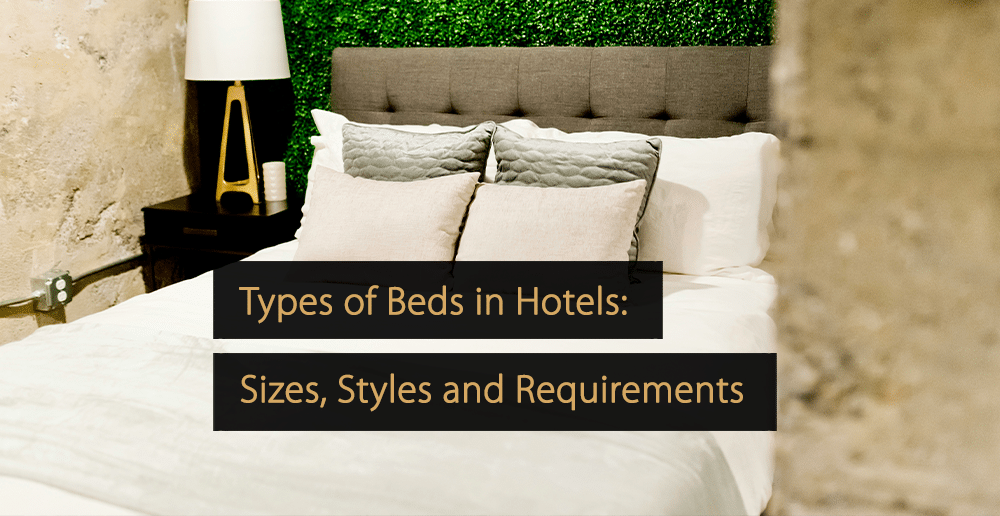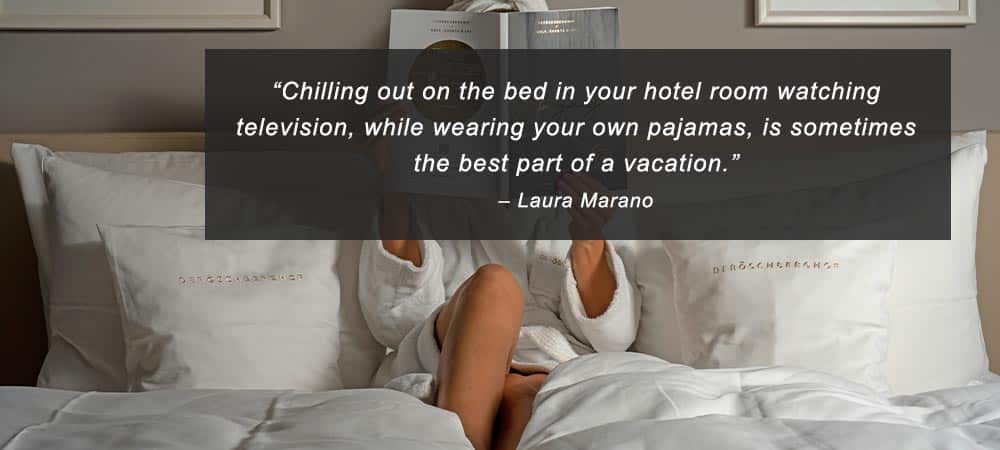The types of beds in hotels are defined by style, size and functionality. Some of the most common options include king size beds, single beds, sofa beds and platform beds.
Offering different types of beds can help to provide guests with choices that suit their particular needs. For instance, the needs of a solo traveler staying for two nights may be very different from the needs of a family staying for a week. In this article, you can learn about the various different types of beds in hotels, how they are defined, what their main advantages are and who they are most likely to appeal to.
Table of Contents:
- What is a Hotel Room?
- Why is Providing a Good Hotel Bed So Important?
- What Are the Requirements for a Great Hotel Bed?
- 10 of the Most Popular Types of Beds in Hotels
- Examples of Cool Hotels Around the World
- The Main Benefits of Smart Hotel Rooms
What is a Hotel Room?
A hotel room is a space sold to hotel guests for temporary accommodation. It may consist of a single room, or multiple connected rooms, such as a bathroom and living space, which are sold under a single room number.
There are many different types of hotel rooms and they are often defined by the types of beds in hotels and specific room features. Examples of room types include single rooms, twin rooms, studios and suites.
In the “Hotel Room Types & Room Pricing Tips for Hoteliers” article, you can explore this topic further, learn how different room types are defined, and gain valuable information about popular pricing strategies.
Why is Providing a Good Hotel Bed So Important?
A good hotel bed will have a comfortable mattress and high-quality sheets, and it will be comfortable to sit and lie down on. It will also be sufficiently supportive and will help to promote a good night’s sleep.
The quality of the beds you provide is important because guests often judge the overall quality of a hotel by the standard of bed provided. A great bed makes guests feel like they are getting value for money, while an uncomfortable or otherwise low-quality bed can have the exact opposite effect.
Sleep quality and the types of beds in hotels can help to determine how enjoyable a guest’s stay is. When they are well-rested, they are more likely to enjoy their daytime activities and more likely to remain in a positive state of mind. This, in turn, leads to a better guest experience and improved customer reviews.
The hotel industry is extremely competitive, and the quality of a bed can become a major competitive differentiator. If you are able to offer guests a comfortable overnight experience, you greatly improve the chances of that customer returning to your hotel in the future or recommending your hotel to friends, family, and colleagues.
What Are the Requirements for a Great Hotel Bed?
In addition to understanding the different types of beds in hotels, it is crucial to understand the basic requirements for a great hotel bed. The best hotel beds will all offer the following:
1. A Supportive Mattress
A good mattress will provide the right level of support for guests, helping to achieve a neutral spinal position. Regardless of the types of beds in hotels, mattresses can either help or hinder relaxation and sleep quality.
Supportive mattresses are important because they help to minimize tension in the body. This not only improves overall sleep quality but also lowers the chances of guests waking up with back, neck, or joint pain.
For those in hotel management, it is important to invest in mattresses that offer soft cushioning, but which still promote even weight distribution and help to keep the spine aligned.
2. High-Quality Bed Sheets
High-quality bed sheets may be the difference between a comfortable or uncomfortable bed. The precise sheets used will depend on the types of beds in the hotel and the targeted level of luxury.
The importance of sheets is difficult to overstate, because they are in direct contact with guests’ bodies. The best sheets will be made from materials like silk or cotton and have a high thread count.
Many hotels use special laundry detergents as part of the hotel room cleaning process. This can ensure the sheets are clean, do not cause skin irritation, and have a pleasant smell.
3. The Right Level of Firmness
Firmness describes the amount of flexibility in a mattress when someone sits or lies down on it. Most good hotel beds are in the medium-firm range because this tends to suit the greatest range of people.
Regardless of the types of beds in hotels, it is important for those beds to be firm enough to accommodate the most common sleeping positions. At the same time, there should be enough flexibility for the mattress to feel comfortable.
It is also essential to understand the difference between support and firmness. Support describes promoting proper spinal alignment, whereas firmness and softness refer to whether the mattress feels hard or soft to sleep on.
4. Clean Bed Linen
Sheets, pillow cases and duvet covers all need to be presentable and they must look clean and crisp. A lot of hotels opt for white bed linen, as this provides a really clean and pleasant aesthetic.
Many guests automatically associate a clean, fresh bed with a good night’s sleep, so the visual quality of the bed can impact sleep quality. This psychological phenomenon can be used to optimize guest satisfaction.
All types of beds in hotels benefit from a clean aesthetic and light colors are generally a safer choice than dark colors.
10 of the Most Popular Types of Beds in Hotels
There are many different types of beds in hotels, and each one has its unique qualities and advantages. In this section, you can learn about some of the most popular bed types and how they are defined.
1. King Size Bed
King size beds are the widest of the commonly available types of beds in hotels. In the US, they measure 76 x 80 inches, although there can be some slight variation and measurements may differ in other parts of the world.
This type of bed is a great choice for any hotel business that wants to provide guests with an added sense of luxury. The width can ensure two people can share a bed in complete comfort.
2. Queen Size Bed
A queen size bed is narrower than a king size bed, measuring 60 x 80 inches. This can make queen beds easier to fit into hotel rooms and buying a queen size bed instead of a king size bed can help to make a room look bigger.
The queen-size bed is ideal for most couples and should still provide plenty of space. This type of bed in hotels can also be used by individual guests for a more spacious and luxurious sleeping experience.
Video: Queen Bed vs King Bed
3. Double Bed / Full-Size Bed
A full-size bed measures 54 x 75 inches or thereabouts. This is one of the most common types of bed in hotels, especially in low-cost properties, and can be broadly regarded as a standard double bed.
While double beds can be used by up to two people, they do not necessarily provide the most spacious experience. However, one of the biggest hotel trends in many parts of the world is the use of double beds for solo travelers.
4. Single Bed
As the name suggests, a single bed is a bed designed to fit one person. These are often used in smaller hotel rooms and may also be included in a larger room in addition to a double bed, allowing an extra person to stay there.
Single beds are an excellent solution for a hotel owner to invest in when they need to save space in a room or maximize total guests. For customers, paying for a room with a single bed is often the most cost-effective option.
5. Twin Beds
Twin beds are two separate beds in an accommodation business. These types of beds in hotels are a common option for guests who want to share a room, but do not want to share a bed.
Most commonly, twin beds are two single beds, although the twin room setup can be achieved with two double beds. In Europe, it is also common for two single beds to be pushed together, functioning like a double bed.
6. California King Bed
A California king bed is similar in use cases and appeal to a king size bed, but measures 72 x 84 inches. This means it is slightly narrower than a king size bed, but also slightly longer.
This increased length over other types of beds in hotels is the primary appeal of the California king bed. It is a perfect option for taller guests, especially if they are over six feet in height.
Video: What do 5 star hotels use for pillows?
7. Zip and Link Bed
Zip and link beds are similar to twin beds because they can be used separately or joined together to form a larger bed. However, in this case, the beds are able to physically connect together at the base.
This physical connection gives zip and link beds greater stability than using twin beds. At the same time, they are still able to be detached, making them more functionally flexible than other types of beds in hotels.
8. Platform Bed
A platform bed is a modern design, with a low-raised bed frame and a wood, metal or slatted surface. It can support a mattress directly, without the need for a mattress foundation or box-spring.
It is becoming more common to see these types of beds in hotels because they have a distinctly modern aesthetic. They are simple, understated and work especially well in minimalist rooms. Most platform beds do not have headboards, footboard, or other additional comfort features.
9. Panel Bed
In many ways, panel beds are similar in appearance and function to platform beds. However, they do not directly support a mattress and so require a box-spring or mattress foundation.
Panel beds also have a more traditional appearance than platform beds and many other types of beds in hotels. They often feature headboards and footboards, although this is not a requirement.
The design of panel beds usually means there is more flexibility in the frame, resulting in a softer feel.
10. Sofa Bed
A sofa bed is a flexible option, serving as a sofa throughout the day and converting into a bed at night. Sofa beds are sometimes used as a secondary bed option, meaning a single room can more easily accommodate multiple guests.
These types of beds in hotels are usually less comfortable than conventional options, but offer a practicality advantage. The ability to transition between a bed and a sofa means they can be used to save floor space during daytime hours.
Examples of Cool Hotels Around the World
What makes hotels cool? There are a variety of factors that can help to create this perception, from the setting and the visual quality of the properties to the technology used, the facilities on offer, and the types of beds in hotels. It can also help if the hotel has unique qualities or features.
In the “Cool Hotels: What Makes a Hotel Cool and What are Some Examples?” article, you can get a better sense of why some hotels are considered cool and access a list of some of the coolest hotels around the world.
The Main Benefits of Smart Hotel Rooms
A smart hotel room is a room equipped with IoT hotel technology. This means ordinary devices are fitted with internet connectivity and the ability to send and receive data. The result? Rooms that provide automation options, greater personalization, enhanced convenience and sometimes even unique types of beds and furniture.
In the article “Smart Hotel Room; What Are the Benefits for Hotel Owners and Guests,” you can learn more about what these rooms are and how they work, and you will also find out why they have grown in popularity.
The types of beds in hotels can significantly impact the guest experience. From king size beds to sofa beds, there are a huge number of options, each with elements that make them useful or desirable to certain guests. By offering multiple options, you can help to ensure your hotel satisfies as many customers as possible.
More Tips to Grow Your Business
Revfine.com is the leading knowledge platform for the hospitality and travel industry. Professionals use our insights, strategies, and actionable tips to get inspired, optimize revenue, innovate processes, and improve customer experience.Explore expert advice on management, marketing, revenue management, operations, software, and technology in our dedicated Hotel, Hospitality, and Travel & Tourism categories.
This article is written by:
Hi, I am Martijn Barten, founder of Revfine.com. With 20 years of experience in the hospitality industry, I specialize in optimizing revenue by combining revenue management with marketing strategies. I have successfully developed, implemented, and managed revenue management and marketing strategies for individual properties and multi-property portfolios.










Leave A Comment